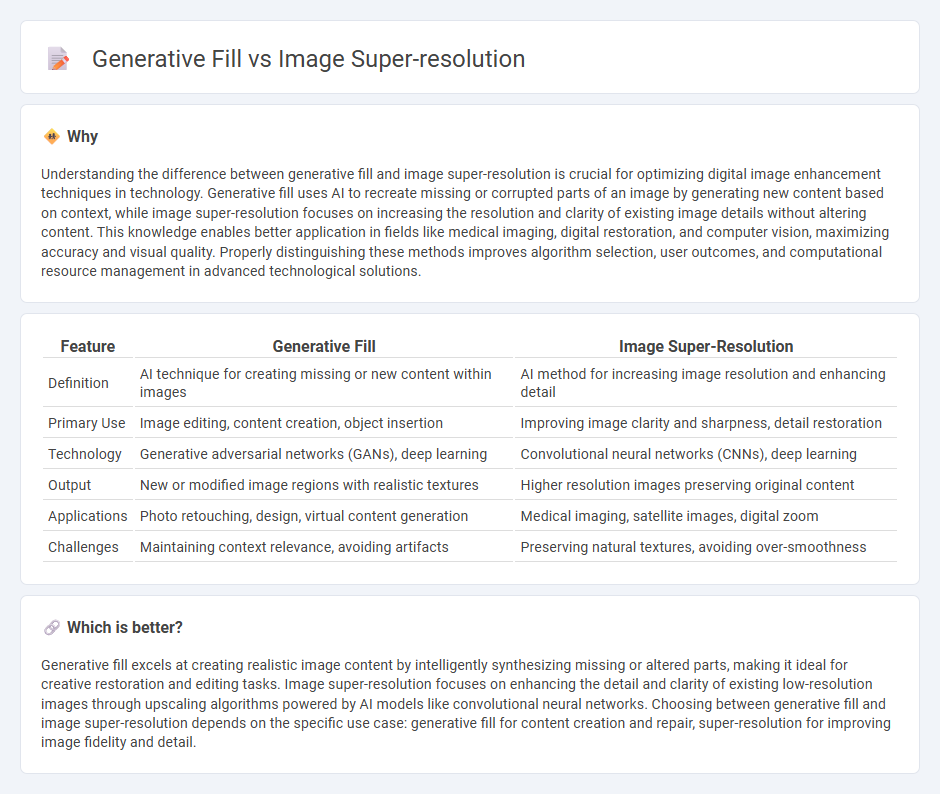
Generative fill leverages AI to seamlessly add or modify image content by predicting and creating pixels that blend naturally with the existing elements. Image super-resolution enhances the clarity and detail of low-resolution images by reconstructing high-frequency information using deep learning algorithms. Discover how these advanced technologies transform visual media in innovative ways.
Why it is important
Understanding the difference between generative fill and image super-resolution is crucial for optimizing digital image enhancement techniques in technology. Generative fill uses AI to recreate missing or corrupted parts of an image by generating new content based on context, while image super-resolution focuses on increasing the resolution and clarity of existing image details without altering content. This knowledge enables better application in fields like medical imaging, digital restoration, and computer vision, maximizing accuracy and visual quality. Properly distinguishing these methods improves algorithm selection, user outcomes, and computational resource management in advanced technological solutions.
Comparison Table
| Feature | Generative Fill | Image Super-Resolution |
|---|---|---|
| Definition | AI technique for creating missing or new content within images | AI method for increasing image resolution and enhancing detail |
| Primary Use | Image editing, content creation, object insertion | Improving image clarity and sharpness, detail restoration |
| Technology | Generative adversarial networks (GANs), deep learning | Convolutional neural networks (CNNs), deep learning |
| Output | New or modified image regions with realistic textures | Higher resolution images preserving original content |
| Applications | Photo retouching, design, virtual content generation | Medical imaging, satellite images, digital zoom |
| Challenges | Maintaining context relevance, avoiding artifacts | Preserving natural textures, avoiding over-smoothness |
Which is better?
Generative fill excels at creating realistic image content by intelligently synthesizing missing or altered parts, making it ideal for creative restoration and editing tasks. Image super-resolution focuses on enhancing the detail and clarity of existing low-resolution images through upscaling algorithms powered by AI models like convolutional neural networks. Choosing between generative fill and image super-resolution depends on the specific use case: generative fill for content creation and repair, super-resolution for improving image fidelity and detail.
Connection
Generative fill leverages AI to seamlessly complete missing parts of an image by understanding context, enhancing visual coherence and detail. Image super-resolution employs deep learning models to increase image resolution, refining texture and clarity through pixel enhancement. Both technologies use neural networks to improve image quality, often combined to restore and upscale images effectively in applications like digital restoration and computer vision.
Key Terms
Upsampling
Image super-resolution enhances low-resolution images by using deep learning algorithms to upsample and reconstruct finer details, improving clarity and sharpness. Generative fill, on the other hand, uses AI to intelligently synthesize missing or damaged parts within an image, often leveraging context to create realistic fills but not primarily focusing on resolution enhancement. Explore how these technologies differ in upsampling techniques and applications to better utilize their strengths.
Diffusion models
Diffusion models excel in image super-resolution by iteratively refining low-resolution images to enhance fine details and overall clarity, leveraging stochastic noise reduction techniques for superior quality restoration. In generative fill tasks, diffusion models synthesize missing or corrupted image regions with context-aware content, producing seamless and realistic completions that align with the surrounding pixels. Explore how diffusion-based approaches transform image enhancement and inpainting by visiting our detailed insights.
Inpainting
Image super-resolution enhances low-resolution images by increasing pixel density and preserving fine details, improving clarity for applications like medical imaging and satellite photos. Generative fill, particularly in inpainting, reconstructs missing or corrupted regions by synthesizing new pixels that seamlessly blend with existing content, using AI models like GANs and diffusion-based methods. Explore how these advanced techniques revolutionize image restoration and creative editing by learning more about their unique benefits and use cases.
Source and External Links
Deep Learning for Image Super-Resolution - This guide discusses different evaluation techniques, learning strategies, and architectures for image super-resolution, highlighting its applications and effectiveness.
Super Resolution in Photos - This feature uses AI to enhance and enlarge low-resolution images, making them suitable for high-resolution displays and printing.
Increase Image Resolution Using Deep Learning - This example demonstrates how to use a very-deep super-resolution (VDSR) neural network to create high-resolution images from low-resolution ones.
 dowidth.com
dowidth.com